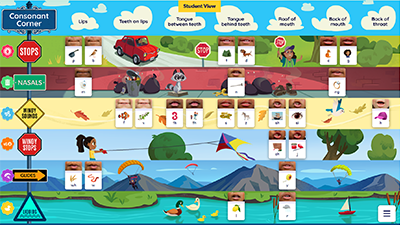Download the Reading Horizons Discovery Sound City™ Vowel Valley and Consonant Corner portable Sound Walls.
Tip: After you print a portable Sound Wall for each of your students, laminate and cover untaught graphemes with a permanent marker. When students study the phoneme and corresponding grapheme in instruction, they can use a dry-erase marker to “reveal” the letter(s) they are learning that corresponds to the phoneme.
Children hear and speak before they learn to read. Sound walls can accelerate students’ articulatory learning and their production of speech, on the road to becoming proficient readers and spellers. In this episode of Literacy Talks, our trio of literacy experts share their experiences and recommendations for integrating sound walls into regular literacy instruction.

WEBINAR
In this edWebinar, literacy experts Stacy Hurst and Lindsay Kemeny introduce viewers to sound walls and how they help students make that vital connection between letters and the sounds those letters represent. This session also dives into interactive technology-enhanced sound walls, an innovation that enables students to practice sound articulation. Sound interesting? It’s the newest horizon in high-impact literacy learning.
In this edWebinar, literacy experts Stacy Hurst, Lindsay Kemeny, and Donell Pons dig into the how, why, and when of using sound walls and the role they play in helping all learners, with a special focus on English language learners (ELLs), make that vital connection between letters and the sounds those letters represent.
What’s the difference between a sound wall and a word wall? What about digital sound walls? What should sound wall instruction look like? Stacy Hurst explains it all in our freshly published blog post.



